Bariloche, Argentina
 After two days of cold and overcast weather, the bright sun greeted us on our last morning in Bariloche with this sparkling view of lake Nahuel Huapi and the Andes beyond. (Click on this and all pictures to enlarge.)
After two days of cold and overcast weather, the bright sun greeted us on our last morning in Bariloche with this sparkling view of lake Nahuel Huapi and the Andes beyond. (Click on this and all pictures to enlarge.)San Carlos de Bariloche, Argentina
Visited November 24 and 25, 2005
Need a map? Click here, but be ready to turn your monitor upside down (or stand on your head).
Our first (and only full) day in Bariloche suffered from the cold and drizzle that assaulted us during the previous day’s lake crossing from Chile into Argentina. However, the second day provided us with a sunny, if blustery, morning to explore this overly-expanding town in an absolutely gorgeous location.

Looking North across Lago Nahuel Huapi to the Andes from Bariloche's port
Architectural Challenges
San Carlos de Bariloche (population around 100,000 and about 2300 feet above sea level) sits in the middle of Argentina’s oldest national park: Nahuel Huapi. You don’t find a name like that easily, so it was reused for the volcano/glacier formed lake. Bariloche sits on the southeastern shore of the 62 mile long Lake Nahuel Huapi. Founded in 1902, Bariloche went nowhere (it’s hard when you’re a piece of land even with a nearby volcano) until the Ferrocarril Roca railroad constructed a line in 1934. Previously, some Swiss residents had constructed alpineish chalets. With the railroad came architect Ezequiel Bustillo who in 1940 designed the civic center buildings, being inspired by buildings in Bern, Switzerland. Bustillo architected several other local buildings including the Bariloche cathedral and some upscale hotels, helping give the town the nickname of the “Argentine Switzerland.”
Unfortunately, since Bustillo’s heyday in the 1930s and 1940s, rapid (rabid?) growth has caused bland high-rise timeshares and hotels to obscure some of the quaint neighborhoods. Here’s a couple typical downtown views where modern architecture struggles to pay homage to Bariloche’s middle-European architecture roots or abandons any attempt at style to build high and cheap.


Whether good or bad architecture, Bariloche's position -- smack dab in the middle of Parque Nacional Nahuel Huapias -- creates the perfect base for four-season outdoor excursions. Nearby skiing, hiking, fly-fishing, rafting, etc., make Bariloche Argentina’s second most visited city. In fact, Bariloche's name is derived from the Indian word for a secret mountain pass over the Andes--it's always been the gateway to the Lakes region. The town is also a center for scientific research but we didn't have time to pursue any of that.
Squares on the Square
Our first excursion found our tour stumbling through the great chocolate shops and then stopping at the civic center. Laid out by Ernesto de Estrada, the square sports several Bustillo-architected buildings now used as the police station, former post office, customs office (now the Museum of Patagonia), tourist office, library, etc. Bustillo built with wood from South America’s cypress-like Alerce trees to trim the dark green-gray toba stone from nearby Mt Carbón).
Here are some shots from around the square:
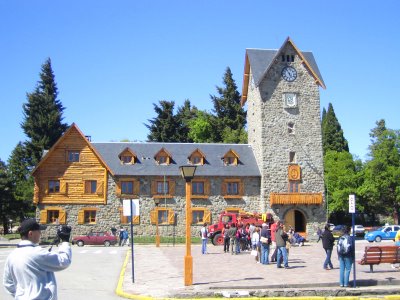
Supposedly at noon and 6PM, this clock tower sports 4 figures representing the area’s history including an Indian, a missionary, a conquistador, and a laborer. As you can see, we were an hour early and, with a plane to catch, missed the noon showing. (Tempus fugit). Here’s another civic center building:
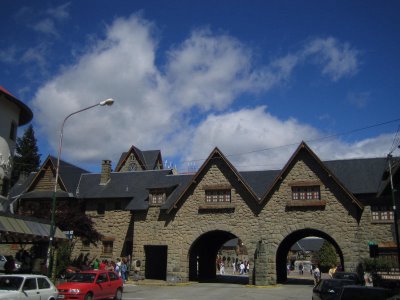
Bully Pulpits anyone?
In a similar building on this square is the excellent Patagonian Natural History Museum named after Perito Moreno, a great naturalist who traveled this area with ex president Teddy Roosevelt in 1913. Moreno eventually donated the land that became the first Argentine National Park. (Totally gratuitous s(n)ide remark: Several other American presidents have shown up here including Eisenhower (who signed the Declaration of Bariloche in 1960) and Bill and Hillary (did I just name two more?) in 1997. The Clintons were discussing emissions and probably left sufficient hot air although not enough to warm us up on our visit.) (Was that enough parentheses for a parenthetical expression?)
The square sported a few wood carvings such as this:

Wisely de Estrada laid out the square so that the lake and mountains are always in view. Here, a not-so-wooden statuesque Indian guide posed for us:

Bariloche rocks
The official name of Estrada’s square is “Expedicionarios del Desierto” named to honor the desert military campaign led by general Julio Argentino Roca (famous enough to get a railroad named after him? Or maybe a whole country?) Roca’s statue now guards the square from pigeons and wisecrackers (is that just a smart white guy?).

Roca’s 1879 campaign pushed out the indigenous people, such as the Toba, from the Pampas. (The “push” was not always gentle and some historians call it genocide). From the looks of Roca’s statue, the natives have returned to rewrite history with spray paint. (In our country, some call that art.) After “subduing” the indigenous people, Roca later served twice as Argentinean president (who hasn’t?)
Besides the spectacular blues of the lake and grey of the mountains, local fauna greens the edges of the square such as this monkey puzzle tree:
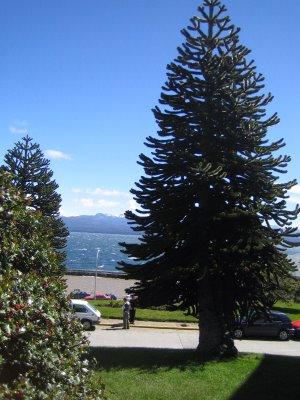
and this huge holly bush:

No tourist trip to the square would be complete without a cheesy picture with the St. Bernard dogs. While we passed on posing with the dogs, we snuck a picture anyway (can you find the whiskey keg? if not, click on the picture to enlarge it:
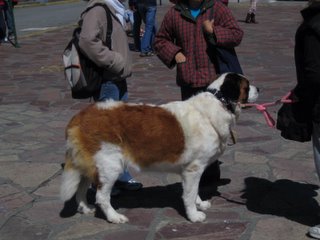
Through the glass shakily
After our visit to the civic center, we took a very windy walk along the eastern edge of the lake shore ending at the neo-gothic 1946 Cathedral:

The Argentine national park system owns the cathedral, called the Cathedral of Nestra Senora de Nahuel Huapi (got to reuse that name!). Bustillo also architected this building, providing it with 50 stain glass windows depicting religious iconery in Patagonian settings. Unfortunately, the cold weather must have shaken my usual steady hand as this was the best picture I could get of the interior:

(Bariloche’s most famous ski area is also called the Cathedral, after the mountain Cerro Catedral; obviously Bariloche has an excess of natural beauty but a shortage of names). In front of this cathedral is a grassy park:
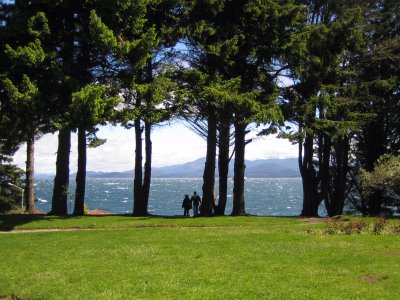
This “Park Italia” contains a statue frequently found in Italy of the founders of Rome: Romulus and Remus being suckled by the wolf who raised them. We're not sure why this is Park Italia other than to pay homage to the large Italian-Argentine population. Italians are one of the three major European groups to settle Argentina (along with the Germans and Spanish). Today the vast majority of Argentines trace their descent from Europe.
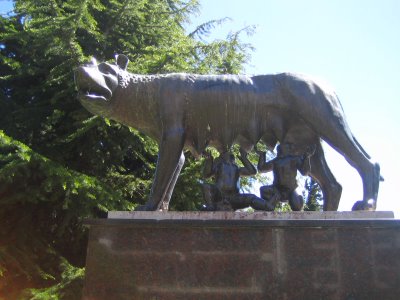
Port Views
Returning westward towards the civic center, we passed the port: Puerto San Carlos with these magnificent lake/Andes view:

Here’s a panoramic of the same view to give you an idea of the sweeping vista. (You’ll probably have to click on the picture to see anything.)

We ended our Bariloche visit with a trip to the airport – eight miles away but through arid terrain quite different from the lush rain forest feel of the rest of Bariloche. Soon we were in Buenos Aires, 1005 miles away.
And now for something completely different…
Ready for a quiz of obscure and totally gratuitous facts? Which Disney film was inspired by the landscape and fauna of the Bariloche and Nahuel Huapi setting? Give up -- (Oh, Deer, it was Bambi!)
----------------------------------------------------------------------
Typical bottom-of-the-blog stuff
Internet Explorer users, want to see more? Then download the Firefox browser by clicking here – these pages work better in it and its more secure.
Where are we now? Click here for an interactive map of Argentina.
----------------------------------------------------------------------
Argentina
Travel
Bariloche
Argentina
Labels: vacation travel
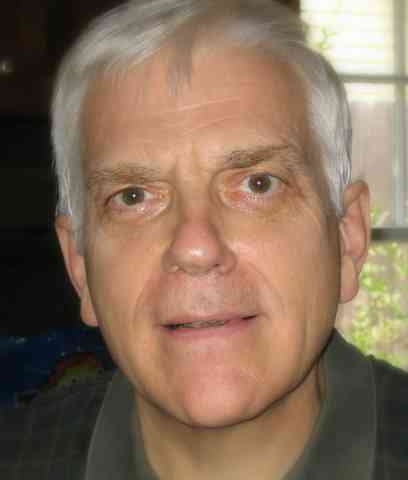

0 Comments:
Post a Comment
<< Home